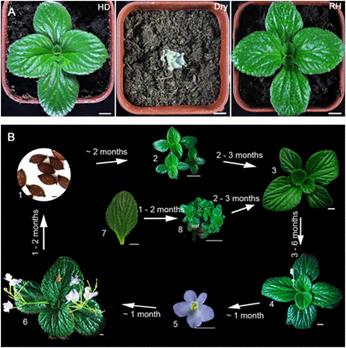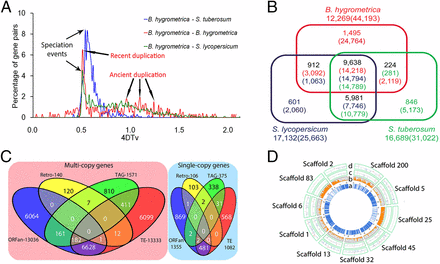朱健康等研究揭示复苏植物耐旱机理
来源:PNAS
作者:朱健康等
时间:2015-05-28


近日,中科院上海植物逆境生物学研究中心研究员朱健康、首都师范大学教授何奕騉与美国密苏里大学研究人员合作,揭示了复苏植物旋蒴苣苔的耐旱机理。相关研究论文已在线发表于美国《国家科学院院刊》。
复苏植物是一类能忍耐严重干旱胁迫植物的总称,在失去自身95%的水分后仍能以一种类似休眠的状态维持细胞活力。复苏植物是研究植物耐脱水机制的特殊模式植物和宝贵的耐旱基因资源植物。但由于缺乏基础的基因组信息,人们并不了解复苏植物如何在叶片和根系脱水的情况下生存下来。
研究人员通过测序,获得了重要复苏植物旋蒴苣苔1.69Gb的基因组草图。基因组分析显示了该植物进化过程中的两次全基因组加倍痕迹。该基因组含有49374个蛋白编码基因,其中29.15%是旋蒴苣苔独有的基因,20%的基因在转录水平上对干燥脱水有显著应答。研究人员还发现,在脱水过程中保护光合结构以及快速恢复蛋白合成的能力对旋蒴苣苔复苏具有非常重要的作用。旋蒴苣苔的复苏能力主要是通过脱水应答基因的调控改变演化出来的。
专家认为,作为一个备受期待的耐旱基因资源植物,该研究将有助于以提高植物耐旱及应激能力为目标的基因改良工作。(来源:中国科学报 黄辛)
The resurrection genome of Boea hygrometrica: A blueprint for survival of dehydration
Abstract “Drying without dying” is an essential trait in land plant evolution. Unraveling how a unique group of angiosperms, the Resurrection Plants, survive desiccation of their leaves and roots has been hampered by the lack of a foundational genome perspective. Here we report the ∼1,691-Mb sequenced genome of Boea hygrometrica, an important resurrection plant model. The sequence revealed evidence for two historical genome-wide duplication events, a compliment of 49,374 protein-coding genes, 29.15% of which are unique (orphan) to Boea and 20% of which (9,888) significantly respond to desiccation at the transcript level. Expansion of early light-inducible protein (ELIP) and 5S rRNA genes highlights the importance of the protection of the photosynthetic apparatus during drying and the rapid resumption of protein synthesis in the resurrection capability of Boea. Transcriptome analysis reveals extensive alternative splicing of transcripts and a focus on cellular protection strategies. The lack of desiccation tolerance-specific genome organizational features suggests the resurrection phenotype evolved mainly by an alteration in the control of dehydration response genes.
原文链接:http://www.pnas.org/content/112/18/5833.full.pdf




